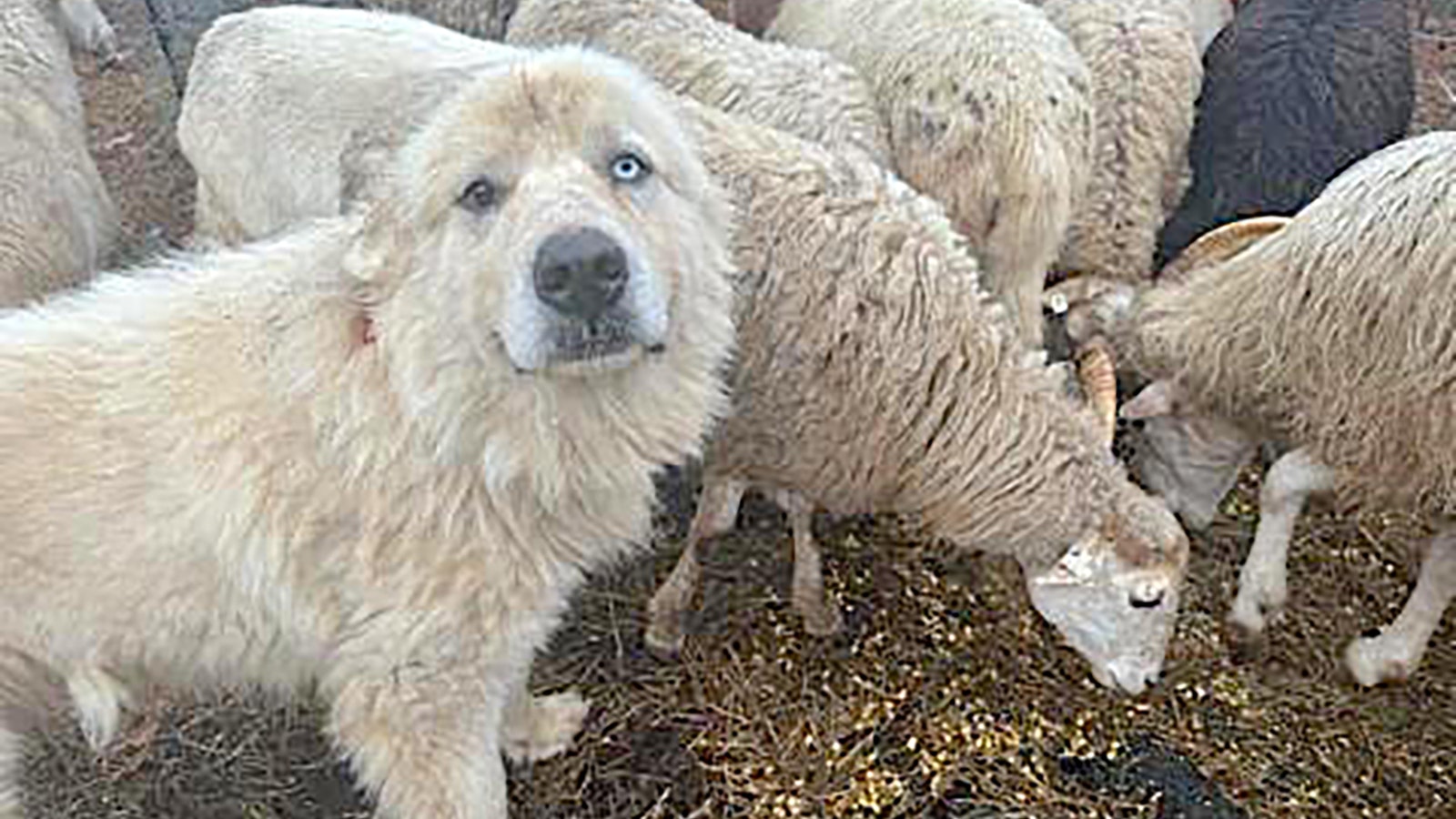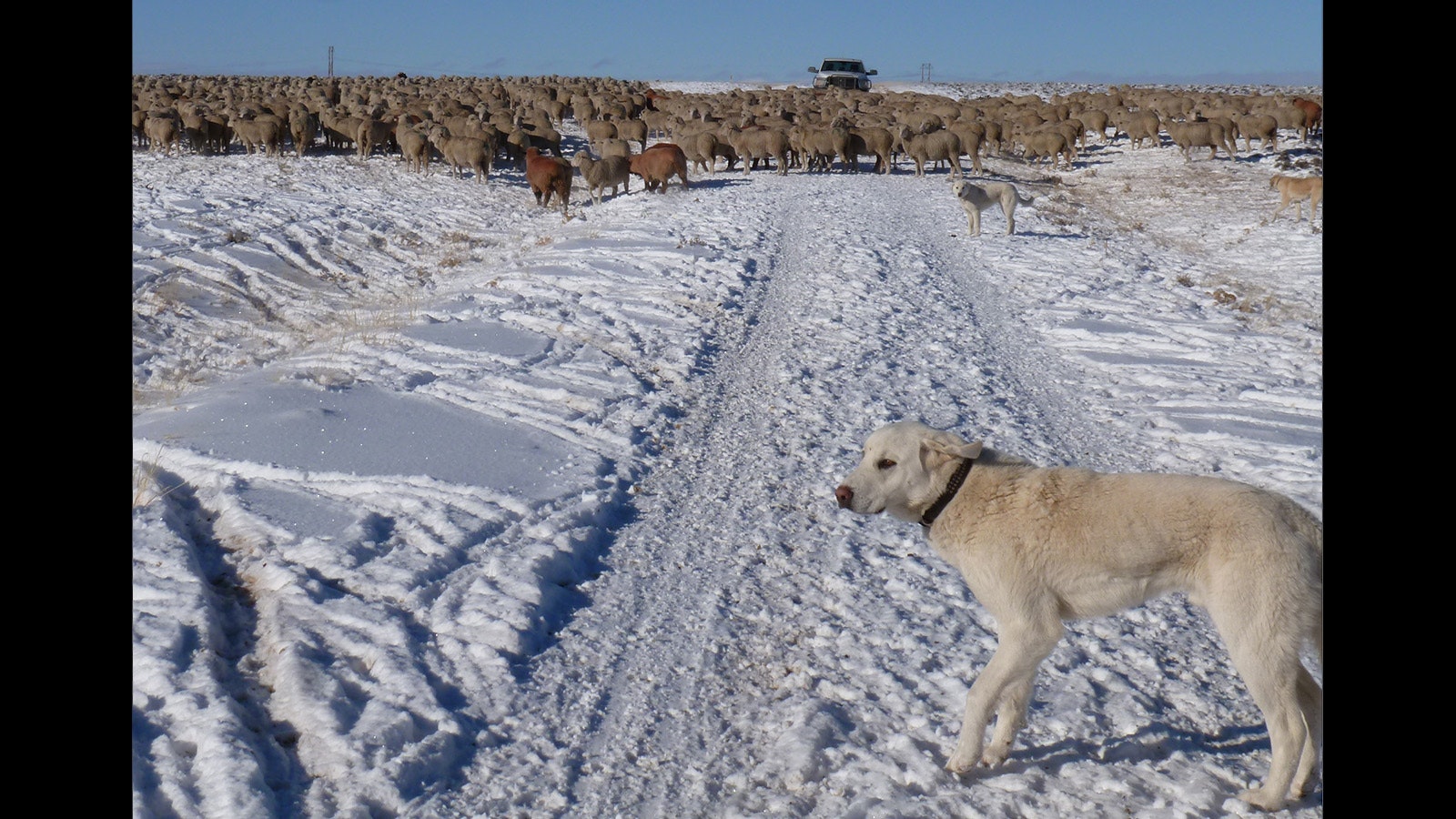A heroic sheepdog that killed eight coyotes in defense of his flock is nominated for Farm Dog of the Year, and is proof of how livestock protection dogs prove their worth day in and day out, say Wyoming ranchers.
A Great Pyrenees named Casper was just a 20-month-old, 85-pound guard dog when the incident happened in Decatur, Georgia, on Nov. 6, 2022. Casper took on 11 coyotes in all, killing eight and chasing after the remaining three.
The dog sustained life-threatening injuries in the fight, but eventually recovered.
Casper might tend to his flock clear across the country, but his story is very much like others closer to home in Wyoming. Great Pyrenees and similar breeds are worth their weight in gold to their owners and the animals they protect.
When it comes to protecting their flock, these sheepdogs will lay down their lives in the performance of their duties.
Dependence On Dogs
“I'm not surprised to hear about this dog. These kind of guard dogs are serious about protecting,” said Sharon O’Toole. She and her family run a sixth-generation sheep and cattle outfit in Savery, Wyoming, called the Ladder Ranch.
“I am surprised, though, he took on that many coyotes and lived,” O’Toole added.
O’Toole’s operation includes thousands of sheep and around 60 dogs to keep them in line and safe. Some are herding dogs — mostly border collie crosses — and the rest are livestock protection dogs. It takes a pallet of dog food a week to keep them all fed.
Ladder Ranch uses, on average, four dogs for every bunch of ewes and lambs numbering around 800-900 head when free-ranging their herds in the high country during the summer months. The sheep are scattered on forest land with only a nearby herder or two and the guard dogs for protection.
Predators are numerous in Wyoming. Sheep predation would quickly make an operation like Ladder Ranch’s unprofitable if not for protection dogs.
“Our sheep are range sheep. Coyotes are always there. Every day there is a threat,” O’Toole said. “Our dogs are pretty effective in keeping coyotes away.
“Many times, we have guard dogs kill coyotes. They are not an ‘attack dog,’ but if a coyote gets near, they can neutralize the threat.”
Guard dogs have their limits, however. Wyoming’s predators are many and vicious. O’Toole has lost her share of dogs to wolves, bears and vehicles.
“They are no match for wolves. I’ve seen guard dogs taken apart by wolves. Wolves can kill any other canine they want to,” O’Toole said. “We’ve had a lot of attrition in our dogs. We’ve had dogs killed by bears. They are no match against grizzlies, but they will put up a ruckus and get the herders’ attention.
“Sometimes they get hit in the road when we are trailing. Some get stolen. Some you never know what happened to them.”
And it’s only gotten worse. Last winter was so harsh it killed off a great many deer and antelope. Apex predators like wolves have less wildlife to feed on, so domestic livestock often provide an easy alternative.
“Now there is no prey for the predators with the deer and antelope gone. Livestock is all that’s left to eat,” O’Toole said. “I realize they are God’s creatures too, just trying to make a living, but what can wool growers do against wolves when nonlethal deterrents are not really effective?”
Casper’s Recovery, Renown
Casper is back on limited duty in semi-retirement these days. His physical injuries have healed, but his mental state remains a bit “tentative,” said his owner John Wierwiller.
In the brush with the pack of coyotes last year, Casper suffered a severed tail, deep puncture wounds and two large patches of skin that were completely town away.
It took more than six weeks at LifeLine Animal Clinic for Casper’s recovery. More than $15,000 was raised for his vet bills, all contributions coming from numerous animal lovers from across the country.
Wierwiller runs a business where he uses a small herd of sheep to “mow down” unwanted vegetation in mostly urban settings around the Atlanta metro area. He fences in the sheep and has a guard dog or two patrol the perimeter outside the fence.
Recalling the incident, Wierwiller said he had his sheep near the house when “total chaos” started. Casper jumped the fence where three of the 11 coyotes had gained access into the enclosure. The Pyrenees made short work of them and then faced off against the remaining coyotes.
By the time Wierwille arrived, he saw Casper biting the coyotes by the head and throwing their bodies over his shoulder. Wierwille’s five other guard dogs safeguarded the sheep (none were lost) while Casper fought off the intruders.
Casper’s loyalty to his charge was never questioned, but he may have had a little extra incentive. His girlfriend Daisy was pregnant at the time with their puppies. Daisy remained with the sheep. The undertrained Casper took off after the three still-living coyotes to finish the job.
He didn’t return for two days.
When he did, Casper looked awful and near death.
“It looked like a coyote grabbed his skin and peeled it right off,” Wierwiller told reporters at the time.
The headline story convinced American Farm Bureau Federation to make Casper a finalist in its Farm Dog of the Year contest. The winner receives a year’s worth of Purina dog food as well as a $5,000 cash prize. A panel of judges will select the winner from among five nominees.
Voters also can cast a ballot online for Casper to win the People’s Choice Award, which comes with a $1,000 prize.
“There are a lot of deserving dogs. It’s an honor for him just to be nominated,” Wierwille told The Washington Post. “He was doing his job, and that’s what I think everybody appreciates about him.”
If he wins, Wierwille said Casper will be enjoying a Wendy’s burger — his favorite food.
Bred For Bravery
Unlike herding dogs, livestock protection dogs do not usually herd sheep.
Acting independently of humans, protection dogs stay with or near livestock most of the time and aggressively repel predators.
Devotion, instinct and a protective nature has been bred into these working canines for centuries. While not widely popular in the U.S. until the 1970s, guard dogs have been used in Europe and Asia for centuries.
O’Toole first started with Komondors, a Hungarian breed known for its distinctive long, corded coat.
“We had the first one in Wyoming I think in about 1980,” O’Toole said. “I remember when we got him, we were expecting something fierce and here comes this fuzzy little puppy.”
But Noodles ended up being great at his job, no complaints from the Ladder Ranch. In fact, O’Toole penned a couple of kids’ books about him back in 1988-1992, published by Scholastic.
“We had a few more Koms after Noodles and I really liked them, but they have this rag mop coat. It’s really hard to take care of that coat in a range situation,” O’Toole said.
O’Toole eventually settled on an Akbash (Turkey)-Great Pyrenees (France) cross.
“The Pyrenees are friendly but tend to wander. Akbash stay with the sheep but can be standoffish,” O’Toole said.
Training a guard dog is very nuanced. Pups are sensitized to sheep from birth to foster that bond. Depending on the rancher, a limited amount of human contact is usually desirable to nurture the dogs’ “sheepiness” and curb any distractions offered by well-intentioned bikers, hikers and anyone else the dogs might run into in the forest.
A well-trained adult dog will usually take it from there, helping round out juveniles, O’Toole said.
“Unlike herding dogs, who just want to please, guard dogs are more independent thinkers. They are a different critter for sure,” O’Toole assured. “If you tell them to sit, they might think about that for a while and see if maybe that works for them. Or doesn’t.”
O’Toole balances that self-determining nature with a minimal amount of domestication. You don't want something so feral it can't be approached, but you also don't want a tail-wagging people-pleaser with a weakness for deserting his post at the first sign of a Milk-Bone.
“Sometimes the sheep are loaded onto trucks or the dogs need vet care. We can't have them so wild we can't handle them when we need to,” O’Toole said. “Also, we don't want them to see a biker, for example, as a threat. We’ve never had a dog attack a person, even if they can look kind of scary, especially if you are already afraid of dogs.”
The best guard dog is one that views anything new as suspicious. Show teeth to a new perceived threat; use teeth on a known enemy.
“Like a Lab wants to retrieve or a border collie wants to herd, these breeds want to guard something. You can't take that out of them,” O’Toole added.
They’re Working Dogs
Due to the remote nature of their work, guard dogs are often miles from civilization with nary a human in sight. O’Toole has had more than one dog enticed by treats from well-meaning campers only to be subsequently “rescued” from what is mistaken as abandonment.
“The first time that happened to us it was up in the Routt Forest and I actually had to get a deputy sheriff with me to get my dog back,” O’Toole remembered.
But most of the time intervening humans find out quickly a sheepdog does not make an ideal family pet and they are dropped off at the nearest shelter.
“Most area shelters know to watch for these breeds and they kind of know us as well, so we get a phone call” O’Toole said.
Jake Nichols can be reached at jake@cowboystatedaily.com.

















